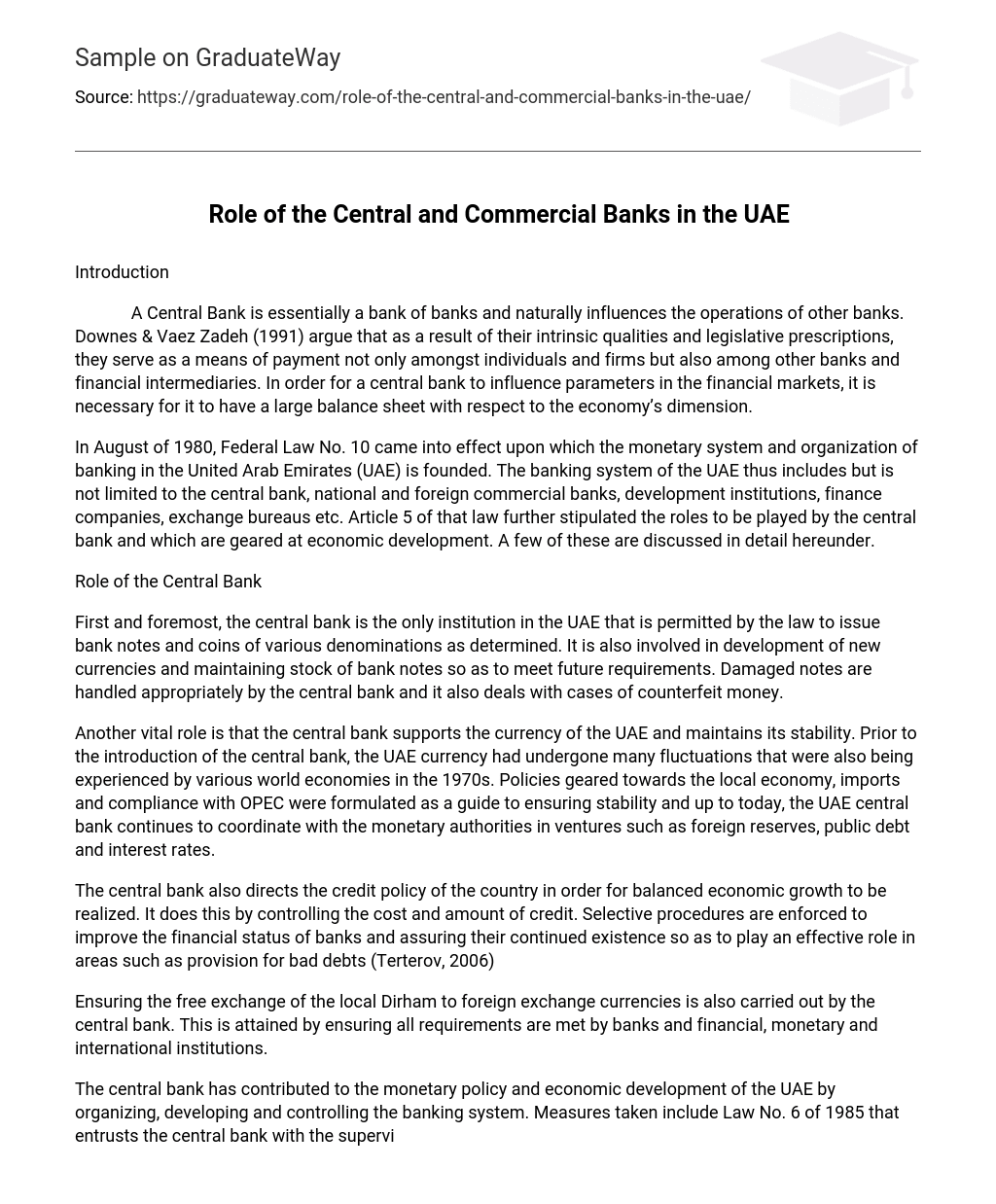Introduction
A Central Bank is essentially a bank of banks and naturally influences the operations of other banks. Downes & Vaez Zadeh (1991) argue that as a result of their intrinsic qualities and legislative prescriptions, they serve as a means of payment not only amongst individuals and firms but also among other banks and financial intermediaries. In order for a central bank to influence parameters in the financial markets, it is necessary for it to have a large balance sheet with respect to the economy’s dimension.
In August of 1980, Federal Law No. 10 came into effect upon which the monetary system and organization of banking in the United Arab Emirates (UAE) is founded. The banking system of the UAE thus includes but is not limited to the central bank, national and foreign commercial banks, development institutions, finance companies, exchange bureaus etc. Article 5 of that law further stipulated the roles to be played by the central bank and which are geared at economic development. A few of these are discussed in detail hereunder.
Role of the Central Bank
First and foremost, the central bank is the only institution in the UAE that is permitted by the law to issue bank notes and coins of various denominations as determined. It is also involved in development of new currencies and maintaining stock of bank notes so as to meet future requirements. Damaged notes are handled appropriately by the central bank and it also deals with cases of counterfeit money.
Another vital role is that the central bank supports the currency of the UAE and maintains its stability. Prior to the introduction of the central bank, the UAE currency had undergone many fluctuations that were also being experienced by various world economies in the 1970s. Policies geared towards the local economy, imports and compliance with OPEC were formulated as a guide to ensuring stability and up to today, the UAE central bank continues to coordinate with the monetary authorities in ventures such as foreign reserves, public debt and interest rates.
The central bank also directs the credit policy of the country in order for balanced economic growth to be realized. It does this by controlling the cost and amount of credit. Selective procedures are enforced to improve the financial status of banks and assuring their continued existence so as to play an effective role in areas such as provision for bad debts (Terterov, 2006)
Ensuring the free exchange of the local Dirham to foreign exchange currencies is also carried out by the central bank. This is attained by ensuring all requirements are met by banks and financial, monetary and international institutions.
The central bank has contributed to the monetary policy and economic development of the UAE by organizing, developing and controlling the banking system. Measures taken include Law No. 6 of 1985 that entrusts the central bank with the supervision of Islamic banks and financial investment institutions. Decrees have also been issued limiting the number of foreign commercial banks in the country.
As earlier stated, a central bank is a bank for other banks and it, therefore, follows that it should render services to commercial banks operating within its borders. These can range from advancing loans, sale of bonds, clearing services and licensing new banks and their branches. It is also the principal government bank which plays an advisory role as well as holding government reserves of gold and foreign currencies (Terterov, 2006). In matters of international transactions with agencies such as the International Monetary Fund (IMF) or other neighboring countries, the central bank acts as an agent by undertaking all transactions on behalf of the government.
Role of Commercial Banks
Commercial banks licensed by the central bank play a vital role in the economic development of any country and this is no exception in the UAE. They play numerous roles chief among them being the promotion of industry and trade. With an increase in commercial banks since the 1970s, trade and industry have expanded tremendously and presently, the UAE is one of the leading financial centers in the Middle East if not the world. This, coupled with the use of bank drafts, bills of exchange, credit cards etc. have revolutionized international trade (Mallakh, 1981).
Commercial banks have also contributed to the balanced development of the various regions of the UAE by transferring surplus capital from the developed areas to the less developed ones. This capital goes to the traders who need it to meet their business needs hence increased investments and trade.
In the UAE in particular, commercial banks have established export promotion cells leading to an overall increase in exports. These promotion cells are charged with informing on the economic conditions prevailing in the country to its customers. This is in turn leads to economic development.
Lastly, commercial banks influence the economy’s outlook by availing credit at determined interest rates. Low rates encourage investments leading to an increased aggregate demand which can only have positive benefits to such sectors of the economy as production.
Conclusion
The UAE central bank has had to overcome numerous challenges since being set up in 1980. It has had to enforce uniform federal laws throughout the emirates as a consequence of the oil boom which saw proliferation of numerous commercial banks. According to Abed & Hellyer (2001) the central bank has maintained a fixed exchange rate for the Dirham and overall, the UAE money authorities have provided the economy with the liquidity it needs.
References
Abed, I. A., & Hellyer, P. (2001). United Arab Emirates: A new perspective. Bookcraft, UK: Trident Press Limited.
Downes, P., & Vaez-Zadeh, R. (1991). The evolving role of central banks: Papers presented at the fifth seminar on central banking. Washington, D.C., USA: International Monetary Fund.
Mallakh, R.E. (1981). The Economic Development of the UAE. London, UK: Taylor & Francis.
Terterov, M. (2006). Doing Business with the United Arab Emirates. London, UK: GMB Publishing Limited.





